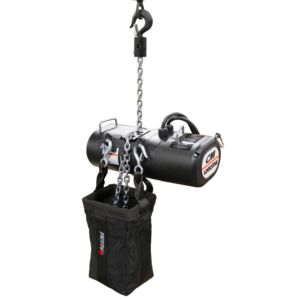
Chain Motor
Rigging is the backbone of live entertainment, and the chain motor is the powerful tool that enables any equipment to be raised to height. With rigging first off of the truck, any show begins with assembling the rigging system designed to meet the distinct requirements of a given show. Using up riggers, ground riggers, and a lot of rope, chain motors can be positioned at any available points within the venue’s structure. Motors come in different weight ratings, but they generally function in the same way. Motor power is connected and the motor climbs up the chain, hoisting the load to the needed height.
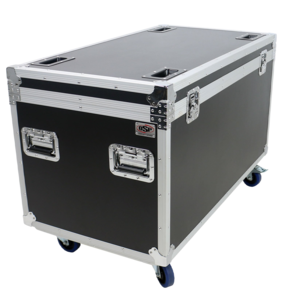
Road Case
Road cases are robust, rolling cases built to transport and protect production gear on tour. They come in all shapes/sizes/styles customized to fit lights, cables, rigging, audio equipment, instruments, wardrobe, production office supplies, and virtually anything needed for a show. These cases are designed to stack on top of eachother for efficiently packing a truck and optimizing space in “dead storage” backstage. Each case is labeled with names, colors, and numbers that indicate what’s inside and where it goes. When pushing road cases, it’s crucial to be aware of your surroundings and watch out for others.
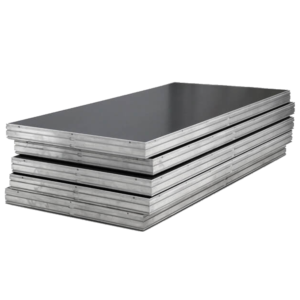
Stage Decks
Finally, the platform that hosts the performance itself – the stage! Stages are versatile, modular structures that come in many shapes and sizes. Typically you will find stages composed of 8×4 decks supported by legs or a frame. Some stages are straight forward while others have complex designs/shapes/features. Stage Decks are also used for risers, FOH, camera platforms, and ramps. During load in/load out they are strapped on large heavy “set carts” for transport, always use 4 people per set cart for safe pushing.
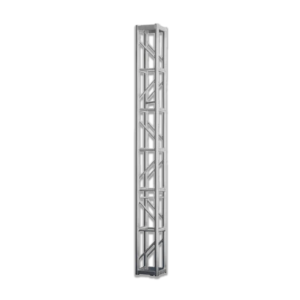
Truss
Truss forms the structure for flying any rig. It serves as the framework for hanging light fixtures, video walls, audio equipment, automation, pyrotechnics, and running the cables to power and control the equipment. Truss can also form ground-supported structures, like entire outdoor stage builds. For shows, trusses can either start empty and stacked on a cart, or come pre-rigged on wheels with fixtures, cables, and rigging already in place.
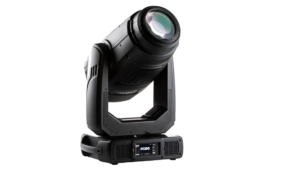
Light Fixtures
There are countless types of lighting fixtures, and they all come together to bring the show to life with different artistic effects. All lights require power and a means of receiving instruction on how to illuminate the stage. Intelligent lights have a plethora of features from color, to shaping and movement that are controlled through data cables. Conventional lights can only control intensity. Lights hang on trusses or pipes by clamps or can be set on stage as floor lights to achieve different effects.

Line Array
Concerts need to produce enough clear sound for large spaces, line arrays are designed to deliver a consistent experience for the whole crowd. Large PA and sub stacks are pinned together and curved to specific angles to accommodate the sound to each venue. There are “main hangs”, “side hangs”, “sub hangs”, and sometimes “delays” which are out in the crowd. On the ground, there can be front fills, floor subs, and on-stage monitors for the performers.
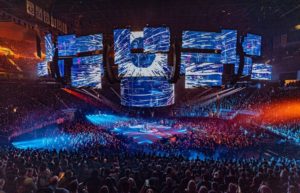
Video Walls
Video walls transform the stage into a large dynamic canvas, they can be used for displaying live camera feed and visual effects. Composed of modular panels, there is nearly no limit to how big some video walls can be. The panels can come off the truck in road cases, or lined up on video carts. If the panels are on carts, they can be lined up side by side and each row is attached, plugged in, and raised up by motors. LED panels can even be implemented into on stage sets/risers and even as stage decks themselves, projection screens may also be used as an alternative display.
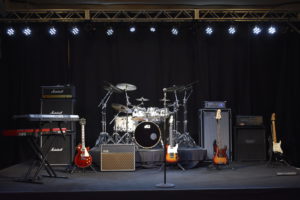
Backline
Backline refers to the band’s musical instruments, and the on-stage equipment necessary to bring their sound to the audience. This includes guitars, pedal boards, amps, keyboards, drum kits, microphones/mic stands, and any other instruments or band gear. Be extremely careful when working with backline, the gear is fragile and the performers need their instruments for the show!

